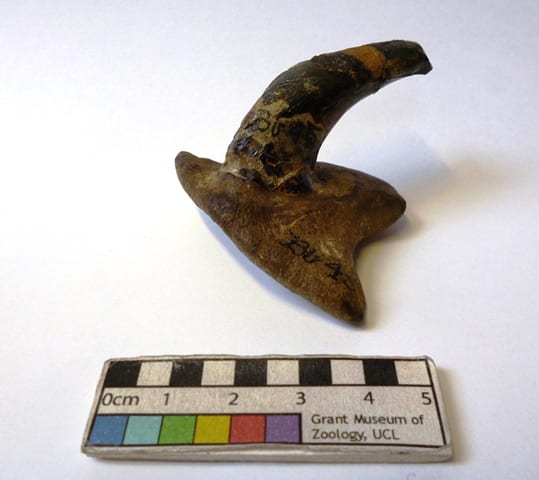Underwhelming Fossil Fish of the Month: April 2015
By Mark Carnall, on 30 April 2015
As we know from the documentary The Devil Wears Prada, fashion is really important because the styles we see on the catwalk today are ridiculous things that nobody in their right mind would wear but then Anne Hathaway dresses nicely and that helps her write Harry Potter and get a boyfriend. How is this relevant to this month’s underwhelming fossil fish of the month, our monthly journey through the museum drawers of uninspiring fossil fish? Well, I’m going to let you into a little secret, a lot* of fashion designers are also keen palaeontologists and if you pay close attention you’ll see a lot of styles from deep time come back into fashion time and time again.
/Cue segue.
This month’s fossil fish is no exception. Some scholars** speculate that this month’s fossil fish inspired the more over-compensatory codpiece design of the 15th and 16th centuries so if you’re prone to tittering or fainting then do brace yourself for disappointment in 5- 4- 3- 2- 1.

This season everyone will be wearing LDUCZ-V1227 Asteracanthus. LDUCZ-V1227 Asteracanthus is the new [ITEM OF FASHION CURRENTLY POPULAR AMONG YOUNG PEOPLE].
This is a fossil cephalic (head) spine and part of its supporting saddle from a fish in the extinct genus Asteracanthus. This spike would have been on the top of the head of the fish, resembling perhaps a certain Darthomiran Zabrak Dark Lord of the Sith. Surprisingly, there are few reconstructions of this spine headed shark, this image from the American Museum of Natural History is the best one I could find although it doesn’t so much resemble Darth Maul as it does Vyvyan from the Young Ones. Head spines may seem very hardcore compared to modern sharks which have toned down that kind of thing for a broader family audience appeal but Asteracanthus was actually one of the more conservative sharks in the family Hybodontidae. Related genera such as Stethacanthus and Falcatus possessed unusual spike covered anvil and ironing board shaped dorsal fins presumably to demonstrate how dark, edgy and alternative they were. The actual function of these dorsal fins isn’t known so the usual grab-bag of reasons are speculated- scaring predators, attracting the ladies and even attacking prey.
This specimen is only identified as Asteracanthus and unfortunately we don’t know where it was collected from so it’s not an easy task to try to work out what species it is as Asteracanthus is a long lived genus found in the Devonian through to the Cretaceous from 400 to 70 million years ago. Asteracanthus is thought to be a free-swimming shark with broad teeth for crushing rather than slicing so it probably fed on crustaceans, bivalves and other hard shelled animals.
Preservation Despite fin spines, teeth and cephalic spines being found through 300 million years of rock deposits whole body fossils are extremely rare, so much so that between 1838 and 1888 the spines were thought to belong to Asteracanthus and the teeth to another genus Strophodus (Woodward 1888). As this individual spine goes, the saddle of the spine is nicely preserved in three dimensions but the spine itself has been painstakingly put together and infilled from at least seven different fragments.
Research Shocking none of the regular readers of this series, Asteracanthus is yet another one of those groups that is name checked as being present in the same deposits containing fossils which are of more interest to academic enquiry. This is probably because Asteracanthus fossils are most frequently found as the odd tooth or spine and it’s hard to draw much in the way of the anatomy of an animal from such scant remains. As recently as 2008 colleagues at Birkbeck, University of London have published more systematic and detailed sampling of English deposits sorting out some of the mess of the woolly designations of the 19th Century including Asteracanthus species (Rees and Underwood 2008)
In society Aside from potentially inspiring codpiece design***, Asteracanthus has not made much of an impact across wider society. However, and I’m breaking embargo here, apparently [FASHION DESIGNER] may be launching a new [FASHION WORD FOR CLOTHES] for this next [SEASON OF THE YEAR] inspired by Asteracanthus! You heard it here first, Underwhelming Fossil Fish of the Month, always with a finger on the pulse of [WORD FOR FASHION].
Asteracanthus sp.
Preservation 4.5
Research 3
Society 1
Underwhelmingness 8
References
Rees, J. and Underwood, Charlie J. 2008. Hybodont sharks of the English Bathonian and Callovian (Middle Jurassic). Palaeontology 51 (1), pp. 117-147. ISSN 0031-0239.
Woodward, A.S. 1888. XLIII.—On some remains of the extinct Selachian Asteracanthus from the Oxford Clay of Peterborough, preserved in the collection of Alfred N. Leeds, Esq., of Eyebury. Annals And Magazine of Natural History. 2;6. pp336–342.
* Not a lot.
**No scholars.
*** Definitely not.
Mark Carnall is the Curator of the Grant Museum of Zoology
3 Responses to “Underwhelming Fossil Fish of the Month: April 2015”
- 1
- 3
 Close
Close


While applauding the obvious associations between fashion and Asteracanthus, I was somewhat disappointed in the lack of the usual superb artist’s impression of what the fish may have looked like. I have come to expect the insightful and fascinating reconstructions which lend so much gravitas and – yes, let’s admit it – sheer sexiness to the whole article. I keenly felt the loss. For shame, sir. For shame!